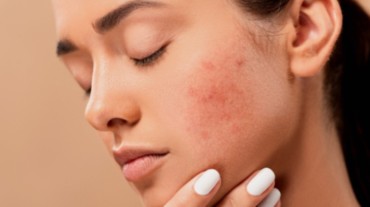
Not all pimples are the same! Acne comes in all shapes and sizes and is generally caused when hair follicles become clogged with excess sebum, an oil produced naturally by our skin to keep itself moisturised. And if you have acne-prone skin, your acne won’t let you rest. Although most of the time, your diet is to be blamed for acne, but if you’re on a balanced diet and just can’t figure out what’s wrong with you, then we’re here to help.
One clue to what’s going on with you is to focus on the location of your acne. In some cases, acne that’s present in a specific area can be linked to underlying health problems. This is known as face mapping. Although mapping like this is not an exact science, finding out how and why acne occurs in certain areas can help you to know about your health status.
Acne present around the hairline and temples is called forehead acne. The forehead is linked to the digestive system. Breakouts in the forehead region are said to represent digestive imbalance, which is linked to a poor diet, irritable bowel syndrome, and improper digestion.
The best thing to do is drink plenty of water, eat a balanced diet, sleep at least seven hours a day, and try to keep the forehead area free from friction.
Acne near the top of your cheeks can be associated with the respiratory system, whereas lower cheek acne is linked to poor dental hygiene and possible environmental triggers in your lifestyle. This could be your skin coming in contact with dirty bed sheets and pillowcases that store bacteria.
To solve the issue, washing them often may help reduce pimples and acne.

The T-zone area is between the eyebrows down to the nose and chin. If you spot acne in this region, remember it is often triggered by gastrointestinal imbalances or food allergens. The worst thing about this area is that there are more oil glands than the rest of the face, which makes it most prone to breakouts. Therefore, excess sebum production can also cause acne.
In fact, acne on the nose can be linked to liver and kidney issues that can simply signify liver dysfunction.
Fluctuations in your hormones can often cause jawline and chin acne, which also reveals an imbalance in your endocrine system. Hormonal acne tends to occur cyclically, and gets worse with menstrual periods and menopause, due to higher relative levels of androgen over estrogen. Some women even notice acne around their neck region due the hormonal imbalance. And in some cases, it can indicate a serious issue like polycystic ovary syndrome (PCOS).
Try a regular sleep schedule and healthy diet, but if you continue having chin acne, consult your dermatologist.
Select Topics of your interest and let us customize your feed.
PERSONALISE NOW
Back, arms, and thigh acne are often caused by hormonal fluctuations and genetics. Sometimes, the type of clothes we wear can also cause irritation to the skin and generate breakouts.
Controlling acne here can be particularly tricky, but you can take certain steps to reduce it. Wear clothes that are clean, soft and not too tight. Make sure to reduce the pressure from carrying a backpack or purse, which can cause friction that causes acne. You can also use sunscreen, body lotion, and home remedies to control the condition.
So ladies, don’t ignore the signs and visit a doctor, if it seems necessary.